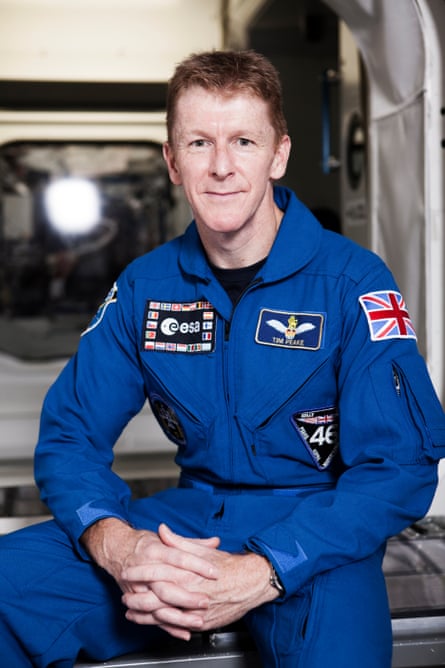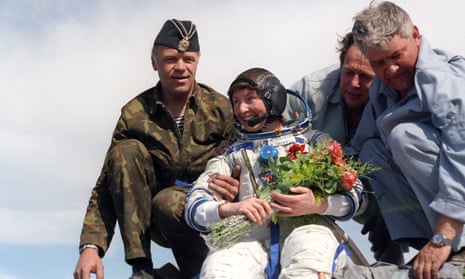When Tim Peake is blasted towards the stars next month on a Russian Soyuz rocket, he will carry an unexpected but highly appropriate gift with him. He will take a book, Road to the Stars by Yuri Gagarin, that was given to him last month by a fellow astronaut, Helen Sharman. This is the copy she took into orbit in May 1991 when she became the first Briton in space.
“Tim asked me if there was anything I had that I would like him to take,” said Sharman. “He wanted to make that link between me, the first Brit in space, and himself, the second. I have kept the book very safe for 24 years and now Tim is going to take it up to the international space station.”
Sharman was given the book when she lived in Star City, the Russian training centre outside Moscow, by fellow cosmonauts as she prepared for her journey to the Mir space station, predecessor of the current space station. “All my crewmates signed the book when we were up there and we gave it the official Mir stamp.”
Now Peake is to follow suit. He and his space station crewmates will also sign the book – a slim volume of Gagarin’s autobiographical recollections – before Peake brings it back to Earth. “Tim and I will then give it to somewhere special, probably in Britain, but we will not decide until he gets back to Earth. It will be a lovely thing to be able to do.”
Peake is set to blast off from Kazakhstan’s Baikonur space centre on 15 December and is scheduled to return to Earth in June. He is Britain’s first official astronaut, a member of the European Space Agency’s astronaut corps. By contrast, Sharman flew as a member of the privately funded Project Juno to the Mir space station in 1991. Several British-born individuals have since flown to space because they held dual nationality and were allowed to fly as US astronauts. Peake is generally regarded as Sharman’s direct successor, however.
The fact that he is taking a book by Gagarin into space is also highly significant. “Gagarin is venerated in Russia,” Sharman said. “He was brave and handsome and, of course, he was the first man in space.” In fact, Peake’s last few days before launch will be preoccupied by following rituals established by Gagarin just before he made his historic flight on 12 April 1961, Sharman revealed.
“There is a log book on the desk in Gagarin’s office and all crew members and backup crew members sign that before launch. Then there is a send-off breakfast – cold meats and bread with Russian champagne – which you have before you fly off from Star City to the launch centre in Kazakhstan.”
Just before launch, astronauts swab down their bodies with alcohol to kill off bacteria and fungal spores, don their spacesuits and check the seals of their helmets. Then, as Peake and his crewmates Yuri Malenchenko and US astronaut Tim Kopra step off the bus that will take them to their Soyuz rocket, they will take part in one last Gagarin-based ceremony. They will urinate on the coach’s rear right wheel.
“When Gagarin was just about to get into his capsule, he decided to have a last pee before going into orbit ‘just in case’ and it has since become a ritual for all male cosmonauts to follow suit,” said Sharman. “I was given dispensation as a woman. Otherwise I would have been forced to take off my whole suit. However, Tim told me he will certainly be following tradition.”
Intriguingly, the Soyuz capsule used for Peake’s mission is exactly the same kind that put Sharman into orbit. (Sharman’s spacesuit and a Soyuz capsule are on display at the Cosmonauts exhibition at the Science Museum in London.) While the US developed its far larger space shuttle before abandoning its use in 2011 after two catastrophic accidents in 1986 and 2003, Russia has stuck with its tried-and-tested Soyuz for almost 50 years now. “It’s incredibly reliable,” said Sharman. “I would much rather fly on Soyuz than the shuttle.”

Sharman was a 27-year-old chemist when she flew on Soyuz, one of the youngest individuals to have made it to Earth orbit. Today, she is operations manager for Imperial College London’s chemistry department. Dressed in an elegant grey jacket and blouse and black slacks, Sharman is an engaging and passionate proselytiser for human spaceflight. The camaraderie she enjoyed with Russian cosmonauts at Star City has remained vivid.
“Valentina Tereshkova [the first woman in space] stayed in the same block of flats at Star City as I did and was tremendously supportive throughout my whole mission. Tim will experience the same sort of thing from other cosmonauts.”
Such close relationships evolve from the intense training cosmonauts undergo together. “You learn to rely on each other,” she said.
On her mission, Sharman’s Soyuz capsule – which normally flies automatically in space – had to be flown manually after flight engineer Sergei Krikalev realised there was a problem with their spaceship’s orbit. “I operated a periscopic TV camera so the commander, Anatoly Artsebarsky, could establish where we were heading. It is real teamwork on Soyuz. Tim will have no trouble with that.”
Unlike Peake, who will spend six months on the space station, Sharman had only eight days in space. However, she learned enough to offer sound advice for Peake. A key problem is space sickness, she said: “It is hard to predict who will get it and Tim has said he will take the anti-sickness pills he is offered. But a key moment comes when you dock with the space station. Until then, you have been cramped in a capsule. Your first temptation is to look down the length of the station when you get inside it and that can disorient you and set you off.”
In contrast to Sharman’s experience on Mir, Peake can expect relative luxury. “On Mir, the lights kept going out because it had developed so many electrical problems. Tim will not have to suffer that though I am sure he will have to do a fair amount of maintenance work up there.”
By contrast, the return to Earth could be one of the nastier aspects of the mission. “You have to undergo a force that is five and a half times that of gravity as you descend. Lift-off is gentler. And of course if you have been in space for a long time, as Tim will have been, you suffer bone and muscle loss no matter what food you eat or what exercise you take. So that will be another painful experience for him, though he will recover.”
The fact that it has taken 24 years for Britain to find a successor to Sharman is “a tremendous disappointment”, she said. “I get standing ovations at meetings when I say Britain should be involved in human spaceflight. Unfortunately that goal has been blocked by a handful of people in high office.
“Yes, human spaceflight is expensive but it grabs the attention much more than robot missions and for much longer. It gets schoolchildren interested in science like nothing else.”
At present, the UK government is providing funds for the European human spaceflight programmes only for the next few years. That has bought us one spaceflight, said Sharman. “Once Tim flies, that is it. However, if the government finds the public is really enthusiastic about his flight, it may that we will have to continue. I hope so.
“Arthur Clarke once said that when an organism stops pushing its boundaries forward, it starts to die. We should be pushing our boundaries. After all, we Britons are explorers and adventurers”
BRITONS IN SPACE
Tim Peake and Helen Sharman are British and do not share citizenship with any other country. By contrast, other astronauts who were born in the UK have had dual nationality or have changed nationality in order to gain a place on a US space mission. They include:
Michael Foale Born in Louth, in Lincolnshire, to a British father and an American mother, Foale went to work for the space industry in Texas before becoming an astronaut, flying on six shuttle missions.
Piers Sellers Born in Crowborough, Sussex, he left the UK for the US where he became a naturalised citizen in 1991. Flew on three shuttle missions.
Nicholas Patrick Born in Saltburn-by-the-Sea, in the Tees Valley, he changed nationality in 1994 and later flew on three shuttle missions.

Comments (…)
Sign in or create your Guardian account to join the discussion